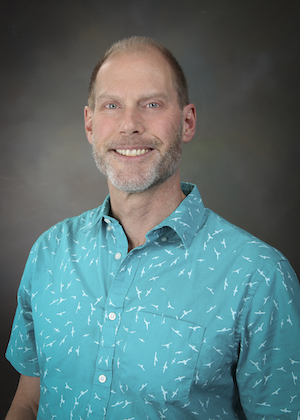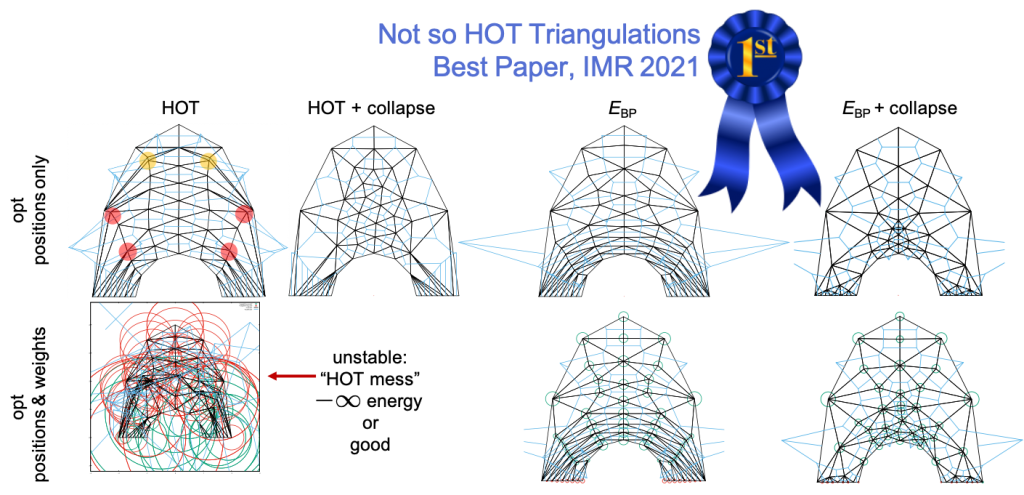Scott A. Mitchell
Principal Member of Technical Staff

Principal Member of Technical Staff
Center for Computing Research (CCR)
Looking for someone else? Other Mitchells
(505) 977-8893
Sandia National Laboratories, New Mexico
P.O. Box 5800
Albuquerque, NM 87185-1320
Biography
I received a B.S in Applied Math, Engineering & Physics from the University of Wisconsin-Madison in 1988. I received an M.S. (1991) and Ph.D. (1993) in Applied Math from Cornell University. I worked the summer of 1991 at Xerox PARC with Marshall Bern and John Gilbert.
Since Oct 1992 I’ve been at Sandia National Laboratories. I researched triangular and tetrahedral meshing algorithms via a computational geometry approach from 1992-1993. I was part of the Cubit project, doing mesh generation R&D from 1993-2000, and project leadership from 2000-2002. I did things like researching algorithms and existence proofs for hexahedral meshes and optimization for assigning the right number of edges locally so the model can be meshed globally. I managed the Optimization and Uncertainty Estimation department from 2002-2007. I served in various capacities on various programs, including LDRD (internal research program) and NNSA’s ASC program. I decided I missed building things and figuring things out for myself and moved on to technical work in 2007. After some informatics projects, I gravitated back to geometry and mesh generation in about 2011, with some connections to computer graphics and uncertainty.
Research
I am currently doing technical work related to mesh generation and improvement, surface reconstruction, sampling, uncertainty quantification, and high dimensional data analysis and high dimensional space exploration. These are within the broader contexts of computational geometry, computer science, discrete math, and information theory. Some older projects included designing a MANET protocol, researching validation process guidelines of computer models of how humans think, low-bandwidth authentication, a military logistics simulator called CoreSim, “forecasting” (uncertainty, statistics, and graph algorithms) over large-scale informatics graphs, and statistical techniques for finding the root-cause of faults in networked computer systems. Some information projects included data-streaming algorithms, e.g. approximate counting; and the geometry of distance functions for comparing probability distributions in information theory.
I’ve looked at sample based techniques, including their uses for mesh generation, integration, and uncertainty quantification. I’ve had several projects using computational topology, and am currently engaged in using it to measure the trade-off between accuracy and simplicity in mesh-based reconstructions of ugly geometry that has been sampled. Often I consider uniform-random point samplings with inter-sample inhibition distances and guaranteed domain coverage, and meshes from these point sets. These Poisson-disk samplings are popular in computer graphics, for integration-like problems such as texture synthesis, and in simulation for fracture mechanics, where non-randomness would spoil the outcome.
Activities
Conferences, Workshops and Outreach
IMR
SIAM IMR Fellow for 2022
I’m the 11th such Fellow. Since 2011 the IMR has named one Fellow each year it has met.
IMR2024 chair of organizing committee. With SIAM PP. Join us in Baltimore!
IMR2023 panel chair. In person for the first time since COVID. In Amsterdam with SIAM CSE.
Older IMR committees I was on the program committee for the 27th International Meshing Roundtable IMR, 1-5 October 2018. I was on the program committee for the 26th International Meshing Roundtable IMR, September 2017, the short-course chair and the papers co-chair. There were probably a couple other times I was on the committee but forgot. I chaired the IMR in 1995.
IMR with SIAM. After 29 years as a successful conference series, the IMR joined SIAM and is now the SIAM IMR, with new website here: https://internationalmeshingroundtable.com/ Meetings continue to be annual, and will be colocated with SIAM PP and SIAM CS&E alternating years.
Non-IMR
CAD Computer-Aided Design editorial board since early 2023.
Symposium on Solid and Physical Modeling (SPM) 2024 international program committee.
I’ve given talks to universities and to Sandia on what it is like being a mathematician at an engineering laboratory. This includes several talks as part of the effort by DOE’s Office of Science labs to inspire and attract students at universities serving underserved communities.
I organized a workshop on combinatorial algebraic topology in late August 2009; we wrote a summary report.
I taught the course “ALGORITHMIC GEOMETRY AND MESH GENERATION” at UNM in Fall 2010.
I was on the committee for the Symposium on Computational Geometry, applied-track, in 2002.
Bridging Theory and Practice
Here is a 2002 paper [bibtex] by Batagelj and Zaversnik about core decompositions of networks that lists me as a “liaison” author linking two cores of Computational Geometry, which I recognize as Cubit™ mesh generation and theoretical mesh generation; see pages 7-8.
Writing
I have the dubious distinction of Jonathan Shewchuk using one of my papers from the 1990’s as an example of standard practices for introductions and conclusions that is “bad writing that’s considered good.” I thought the same thing as he did while I was writing it: “No value added, but it’s expected.” (I’m flattered he says the paper has high technical merit despite that.) See “Conclusions that don’t” in Three Sins of Authors in Computer Science and Math, and my paper Cardinality Bounds for Triangulations with Bounded Minimum Angle.
More advice I reread from time to time: abstract for experts vs. introduction for beginners and abstract in six easy sentences and Good Enough Practices in Scientific Computing and single-tasking and reviewing papers, an introduction.
Tau vs. Pi
Let us use tau instead of pi: τ=2π tau = 2 pi [ The Tau Manifesto by Michael Hartl]. Anyone who has messed with hypersphere volumes and areas should appreciate that.
n?
Let us use ? for sum as ! is for product: n? = 1 + 2 + … + n = n(n+1)/2 n? = 1 + 2 + … + n = n(n+1)/2 n? = sum_{i=1:n} i = n(n+1)/2 [my idea]
Programmatics
From 2002-2005 I served on the LDRD S&T CIS IAT (Laboratory Directed Research and Development, Science & Technology, Computer and Information Sciences, Investment Area Team). This is an team that determines the general direction of the most fundamental CS and IS research at Sandia and selects from among the technical staff’s specific proposals. See the LDRD homepage (Sandia Only).
